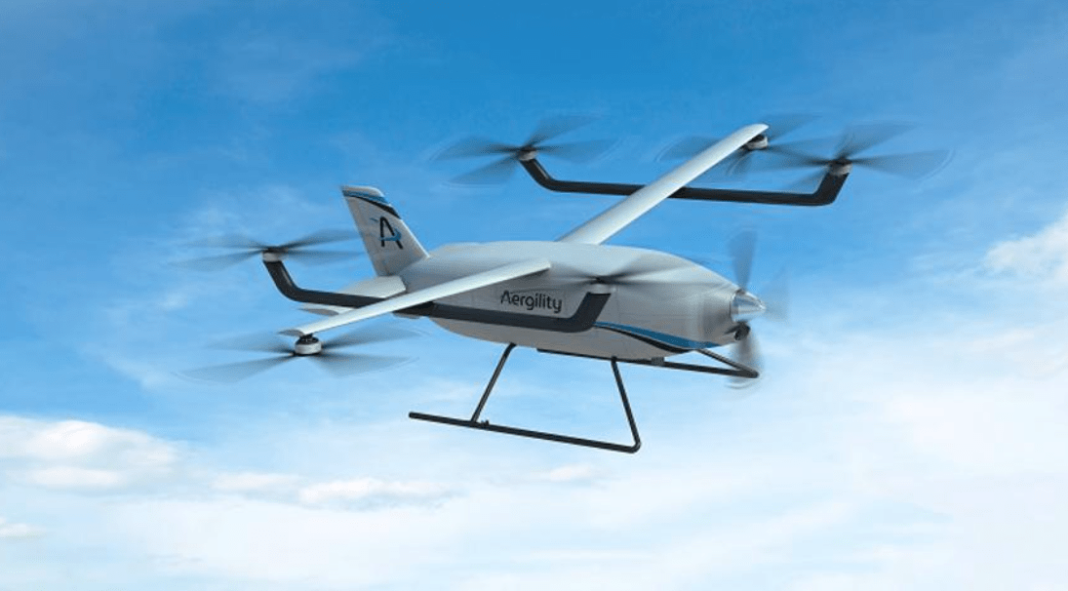What’s shaping up to be a dogfight for a place in the burgeoning unmanned aircraft delivery industry is about to see the prototype for an innovative new combatant. On Monday, Aergility Corporation will take the wraps off the first full-size prototype of its ATLIS hybrid cargo vertical takeoff and landing unmanned aerial vehicle at the AVUSI Xponential conference in Orlando, Fla. In other words, a drone that carries cargo.
But what sets the ATLIS off from other cargo drones now under development is what makes it takeoff and fly—Aergility’s patented Managed Autorotation Technology or MAT.
“It’s like a hybrid hybrid—fuel and electric, plus two fundamental ways of flying: multirotor and autogyro,” explained Aergility director of sales and marketing Brian Vander Mey in an interview.
The ATLIS uses six fixed-pitch, nine-foot diameter electric rotors for takeoff and landing. Airborne forward propulsion is handled by a 90 kilowatt multifuel turboprop engine, which also recharges the batteries for the rotors in flight. In forward flight, lift is provided by a small cord wing and airflow through the rotors like an autogyro.
“The rotors carry half the load and the wing is carrying half the load. It’s a very efficient system,” Aergility founder and CEO Jim Vander Mey, who is also Brian’s father, told Forbes.com. “The principle is the same as a gyro plane. The whole aircraft is controlled by the variation of RPMs. The engine pulling it through the air, the energy for the rotors is coming from the air going through the rotors.”
The result is a compact unit that can actually be broken down and transported by trailer, but with the ability to carry fairly heavy loads for several hundred miles.
“It can carry a useful load of 600 pounds,” said Jim Vander Mey. “It’s a hybrid split between fuel and payload. If you want to carry 400 pounds you can go 600 miles. If you want to carry 500 pounds you can go 300 pounds with a standard tank.”
Cruising speed is 100 miles per hour.
The ATLIS is designed to fly autonomously but for testing purposes some operations are conducted by remote control.
Unlike some other companies developing cargo drones, Aergility isn’t looking, initially, at going after the package delivery business, but rather serving humanitarian and military needs, especially in remote or dangerous locales.
“There’s a big opportunity in the developing world, not in the U.S.,” explained Jim Vander Mey. “Instead of worrying about the last mile delivery you really need to worry about the last hundred miles and this will enable the possibility to build a logistics system that can deliver these kinds of things cost effectively, quickly, without having to have all that infrastructure. We think there’s a huge market for that.”
The ATLIS’s intended use informed the design for how it’s loaded. Rather than pick up pods or shipping containers its tail opens like the hatch of an SUV so odd-shaped and assorted items can just be tossed in the 40 cubic foot cargo hold. They can also be tied down or latched.
The version of the ATLIS to be unveiled next week is actually the third prototype but the first one at full size. At least one more is planned before the expected production version.
The elder Vander Mey describes himself as a “serial entrepreneur” who started Aergility seven years ago. He describes it as “effectively a virtual company” with partners and vendors in 11 countries. He said some initial funding came from a private investor with most “from a customer who believed in the concept and said we need this.” Vander Mey declined to identify the customer.
The plan, he said, is to eventually build a facility in Dunnellon, Fla., about 90 miles north of Tampa, but there’s still work to do.
“We’re not yet at the point where we’re ready to produce any products,” said Vander Mey. “We’ve got a prototype and got more testing to do but we’ve been flying scale models and they fly extremely well so the technology is proven and we’re ready for the next step.”



